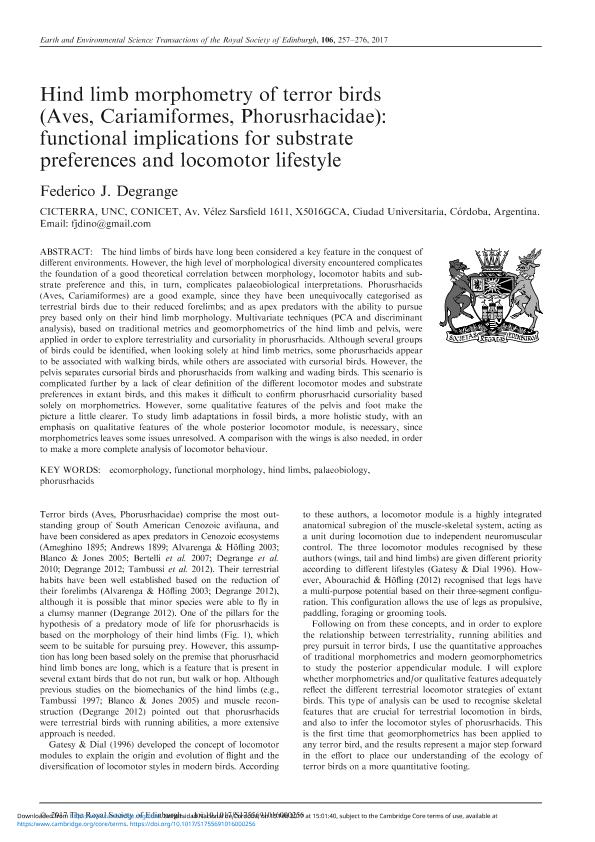Artículo
Hind limb morphometry of terror birds (Aves, Cariamiformes, Phorusrhacidae): Functional implications for substrate preferences and locomotor lifestyle
Fecha de publicación:
02/2017
Editorial:
Royal Society of Edinburgh
Revista:
Earth and Environmental Science Transactions of the Royal Society of Edinburgh
ISSN:
1755-6910
Idioma:
Inglés
Tipo de recurso:
Artículo publicado
Clasificación temática:
Resumen
The hind limbs of birds have long been considered a key feature in the conquest of different environments. However, the high level of morphological diversity encountered complicates the foundation of a good theoretical correlation between morphology, locomotor habits and substrate preference and this, in turn, complicates palaeobiological interpretations. Phorusrhacids (Aves, Cariamiformes) are a good example, since they have been unequivocally categorised as terrestrial birds due to their reduced forelimbs; and as apex predators with the ability to pursue prey based only on their hind limb morphology. Multivariate techniques (PCA and discriminant analysis), based on traditional metrics and geomorphometrics of the hind limb and pelvis, were applied in order to explore terrestriality and cursoriality in phorusrhacids. Although several groups of birds could be identified, when looking solely at hind limb metrics, some phorusrhacids appear to be associated with walking birds, while others are associated with cursorial birds. However, the pelvis separates cursorial birds and phorusrhacids from walking and wading birds. This scenario is complicated further by a lack of clear definition of the different locomotor modes and substrate preferences in extant birds, and this makes it difficult to confirm phorusrhacid cursoriality based solely on morphometrics. However, some qualitative features of the pelvis and foot make the picture a little clearer. To study limb adaptations in fossil birds, a more holistic study, with an emphasis on qualitative features of the whole posterior locomotor module, is necessary, since morphometrics leaves some issues unresolved. A comparison with the wings is also needed, in order to make a more complete analysis of locomotor behaviour.
Palabras clave:
Ecomorphology
,
Functional Morphology
,
Hind Limbs
,
Palaeobiology
,
Phorusrhacids
Archivos asociados
Licencia
Identificadores
Colecciones
Articulos(CICTERRA)
Articulos de CENTRO DE INVEST.EN CS.DE LA TIERRA
Articulos de CENTRO DE INVEST.EN CS.DE LA TIERRA
Citación
Degrange, Federico Javier; Hind limb morphometry of terror birds (Aves, Cariamiformes, Phorusrhacidae): Functional implications for substrate preferences and locomotor lifestyle; Royal Society of Edinburgh; Earth and Environmental Science Transactions of the Royal Society of Edinburgh; 106; 4; 2-2017; 257-276
Compartir
Altmétricas




